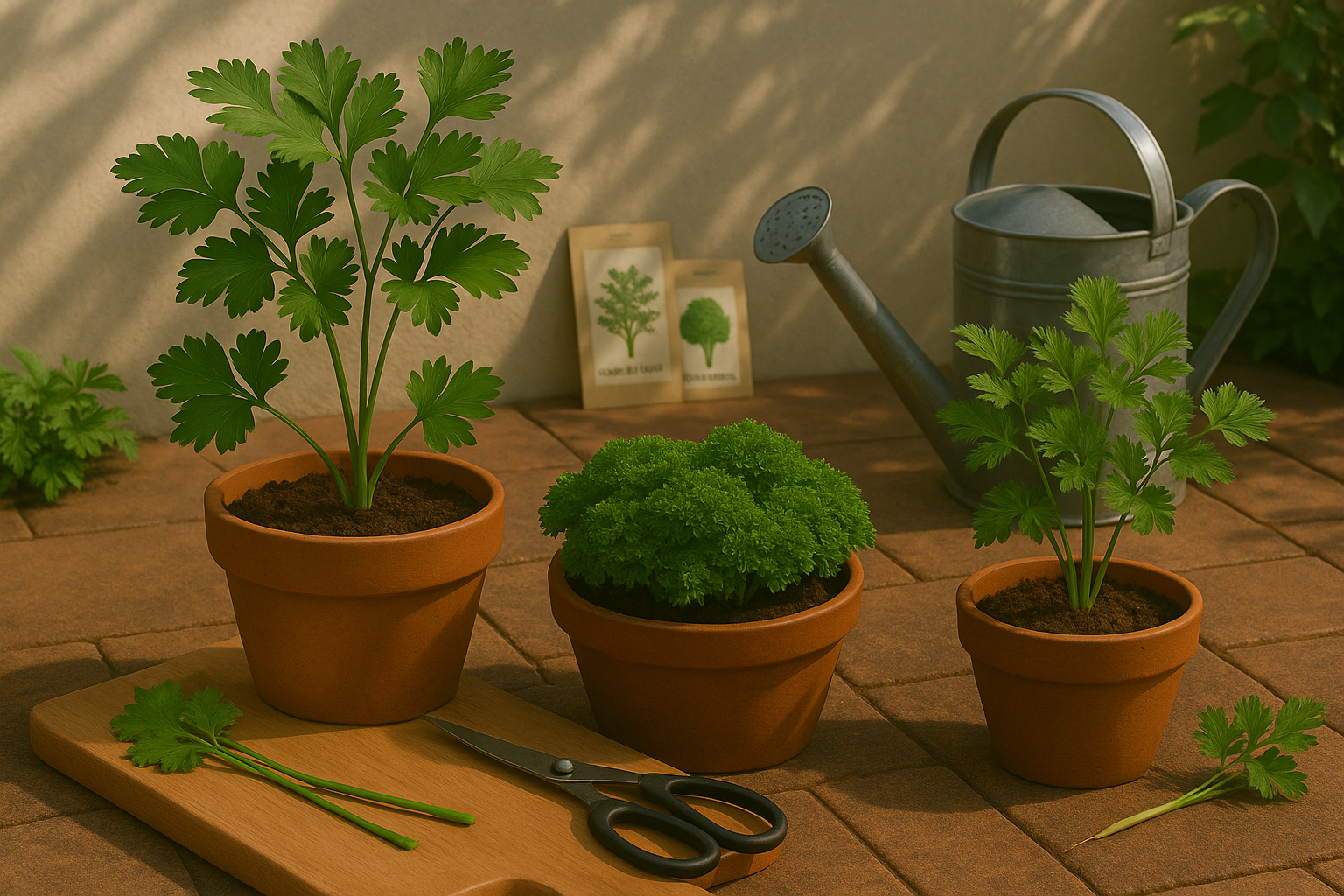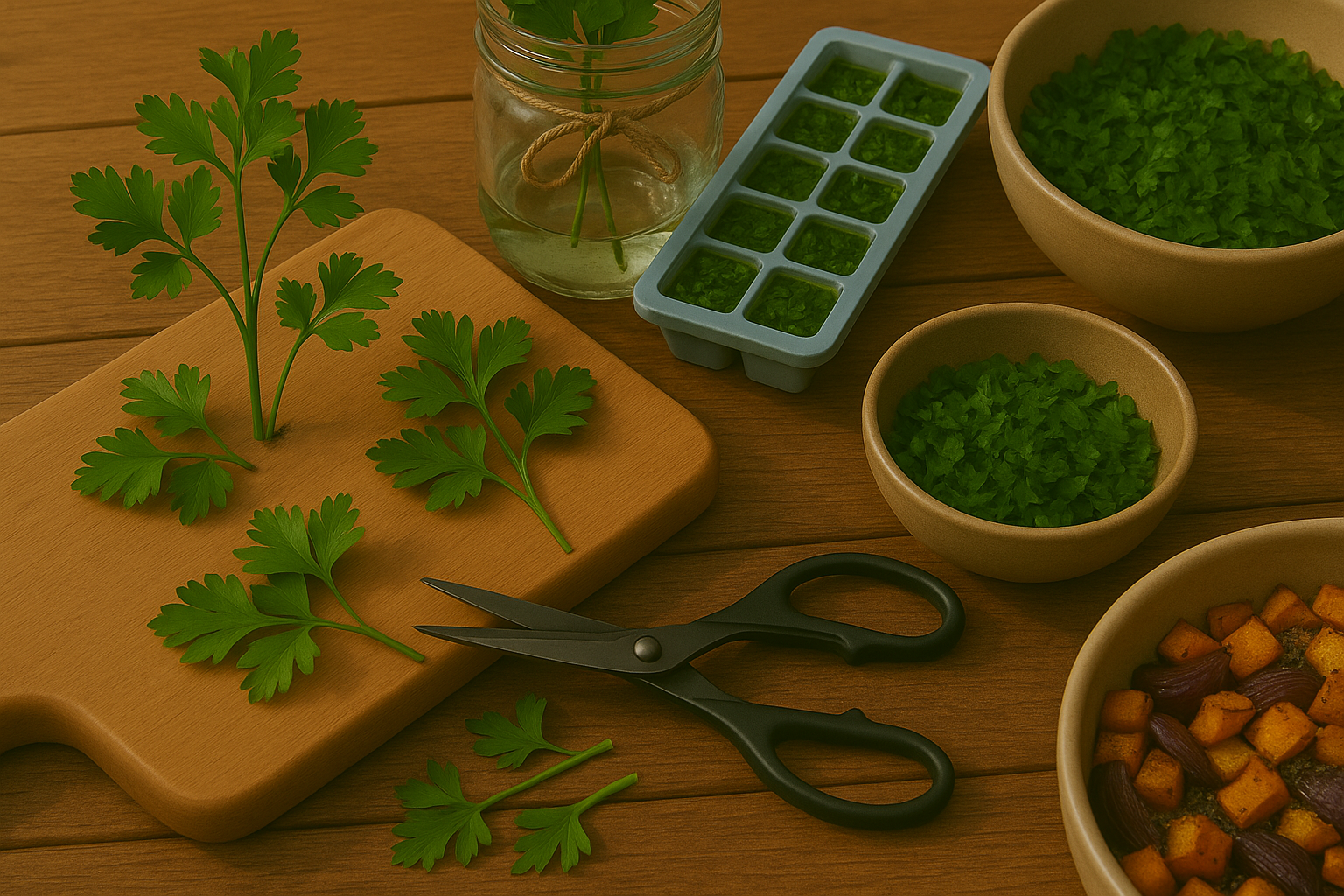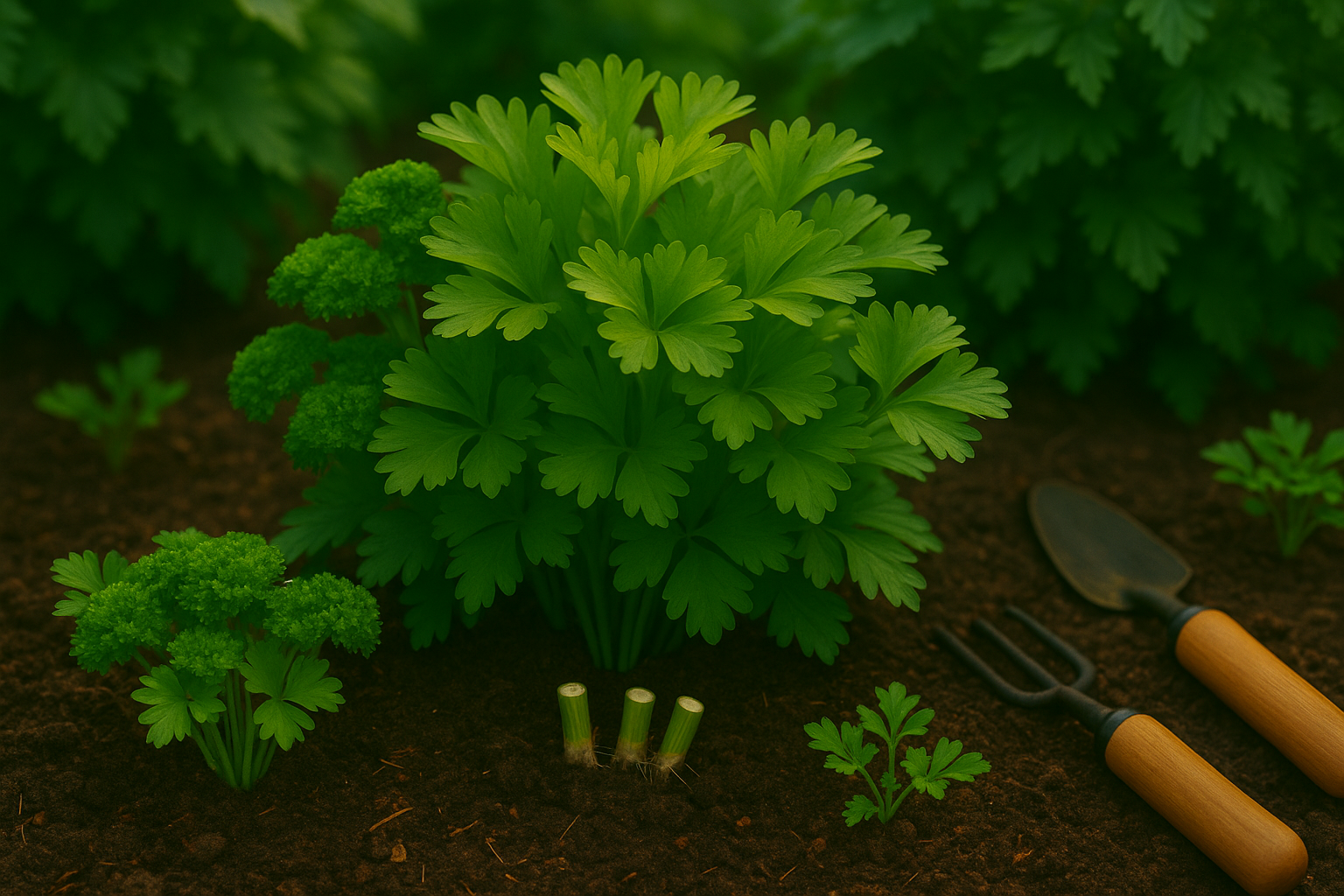Introduction
If you’re searching for the best parsley varieties to add vibrant flavor and fresh greenery to your kitchen, you’re not alone. Parsley is much more than a garnish—this versatile herb is a staple in countless cuisines worldwide, from Middle Eastern tabbouleh to Italian sauces. Packed with vitamins K and C, parsley supports bone health and boosts immunity, making it a smart addition to a healthy diet.
Growing parsley at home offers huge rewards: you’ll always have a supply of crisp, flavorful leaves on hand, and you can skip the wilted bunches from the grocery store. Plus, parsley thrives in containers or garden beds, making it perfect for gardeners with any size space—even a sunny windowsill can yield a thriving plant.
In this article, we’ll explore the best parsley varieties you can grow at home, from classic flat-leaf (Italian) and curly-leaf types to unique cultivars bred for extra flavor, color, or hardiness. Whether you’re looking for robust herbs to chop into salads, delicate leaves to garnish dishes, or hardy varieties that stand up to colder climates, you’ll find options to suit every taste and garden setup. Get ready to elevate your culinary creations with homegrown parsley!
Popular Types of Parsley

When it comes to parsley, three main types stand out: curly leaf, flat-leaf (Italian), and root parsley. Curly leaf parsley is probably the most familiar, known for its frilly, bright green leaves that make it a favorite garnish on restaurant plates. While attractive, its flavor is mild and slightly grassy, so it’s often used more for aesthetic appeal than taste.
On the other hand, flat-leaf or Italian parsley features flat, broader leaves and packs a stronger, more robust flavor—think peppery and fresh, with a hint of earthiness. This makes it the go-to choice in kitchens for adding depth to salads, soups, sauces, and chimichurri.
Root parsley, distinguished by its white, parsnip-like root and feathery greens, is less common in the U.S. but big in Eastern European cuisine. Its root has a subtly sweet, nutty taste perfect for roasting or adding to stews, while the leaves can be used much like other parsley varieties.
Among home gardeners, flat-leaf parsley wins the popularity contest thanks to its vigorous growth, reliable flavor, and versatility in recipes. Curly parsley is still appreciated for easy, attractive garnishing, especially in container gardens or window boxes, though it requires frequent harvesting to prevent legginess. Root parsley, while offering a unique culinary twist, is less common simply because it demands more growing space and a longer season to develop its edible roots.
No matter which type you choose, growing parsley at home is rewarding—you’ll always have fresh sprigs ready for any dish.
Top Parsley Varieties to Grow at Home

When choosing parsley varieties to grow at home, it helps to know the three main categories: flat-leaf, curly-leaf, and root parsley.
Among flat-leaf types, ‘Giant of Italy’ stands out—it produces tall, robust plants with broad, deeply green leaves and an intense, bright flavor that’s prized in Mediterranean cooking. This variety is a favorite for gardeners in warmer climates, thanks to its heat tolerance. Its upright growth makes it easy to harvest and perfect for cutting gardens or culinary herb beds.
For smaller spaces or container gardens, ‘Moss Curled’ parsley is an excellent choice. Its finely ruffled leaves grow densely, creating a compact, decorative mound ideal for borders or patio planters. ‘Moss Curled’ offers a mild, slightly sweet flavor and is extremely forgiving—great for beginners and adaptable to cooler, temperate conditions.
If you’re seeking something truly unique, consider ‘Hamburg’ parsley. Unlike other varieties, ‘Hamburg’ is grown for its edible root, which looks similar to a parsnip and delivers a nutty, earthy taste that shines in soups and roasted dishes. It thrives in well-drained, sandy soils and does best in cooler growing regions with long seasons.
For gardeners in hot, arid areas, ‘Italian Dark Green’ flat-leaf parsley can handle the heat and resists bolting, while ‘Triple Curled’ curly parsley performs fantastically in northern regions and resists cold snaps.
No matter your space or region, start with a couple of types to see which grows best and fits your cooking needs—flat-leaf for robust flavor, curly for garnish and beauty, and root parsley for adventurous eats. Rotate your varieties over seasons for year-round harvests and maximum enjoyment from your home garden.
How to Select the Right Parsley Variety for Your Garden
Choosing the right parsley variety for your garden starts with considering how you’ll use it in the kitchen. Flat-leaf parsley, also called Italian parsley, has a robust flavor that’s ideal for cooking, while curly-leaf parsley is milder and often used as a garnish—so pick based on your taste and favorite recipes.
Next, think about your growing environment: parsley thrives in well-drained, fertile soil and prefers full sun but can tolerate partial shade. If your garden is shaded or your soil tends to retain water, select a variety known for adaptability, like Gigante d’Italia, which is more forgiving.
Disease resistance is important too, especially in humid areas where fungal problems can occur. Look for varieties known for tolerance to downy mildew and leaf spot, such as ‘Premier’ or disease-resistant hybrids available from quality vendors.
It’s also smart to balance aesthetics with practicality: curly types add ornamental appeal to beds and borders, while flat-leaf tends to grow taller and is easier to harvest for frequent use.
To set yourself up for success, source seeds or starter plants from local nurseries or well-reviewed online suppliers who specialize in herbs. This ensures healthy, true-to-type plants adapted to your climate. If possible, check seed packets for sell-by dates and germination rates to avoid disappointment at planting time.
By matching parsley variety to your cooking needs, environment, and garden design, you’ll enjoy a thriving harvest that fits seamlessly into both your meals and your outdoor space.
Planting and Growing Tips for Healthy Parsley

Parsley thrives best in rich, well-draining soil amended with compost, ideally with a pH between 6.0 and 7.0. The plant loves a spot that gets full sun for at least six hours a day, though in hotter climates, a little afternoon shade helps prevent wilting.
When planting parsley, you can either direct sow seeds outdoors after the last frost or start them indoors 6–8 weeks early for a head start. Parsley seeds are slow to germinate—soak them overnight before sowing, then plant about ¼ inch deep. If starting indoors, use seed trays and keep the soil moist until sprouts appear.
Once seedlings have a couple of true leaves, transplant them outside, spacing each plant 8–10 inches apart to prevent overcrowding. Consistent moisture is key for healthy, lush growth, so water regularly, keeping the soil evenly damp but not waterlogged. Mulch around the base can help retain soil moisture and keep weeds at bay.
Growing and Maintenance Tips
- Thin seedlings to keep the strongest plants, giving them room to mature and maximizing your parsley yield.
- Harvest regularly by snipping the outer stems at the base; this encourages new growth and prolongs productivity.
- For pest management, watch for aphids and caterpillars. Spraying with a gentle soap solution or handpicking pests usually works well.
- Remove any yellowing or damaged leaves promptly to prevent disease.
- Fertilize lightly with a balanced, slow-release fertilizer every month during the growing season.
With these simple steps, you’ll enjoy a continuous supply of fresh, healthy parsley for your kitchen well into fall.
Harvesting, Storing, and Using Your Parsley

To get the best flavor from your parsley, harvest the outer stems once the plant has at least three sets of leaves, ideally in the cool morning hours when the oils are most concentrated. Use sharp scissors or garden shears to snip close to the base; this not only preserves delicate leaves but also encourages bushier regrowth.
For ongoing harvests, avoid over-trimming—never take more than one-third of the plant at once.
Fresh parsley keeps well in the fridge: rinse, pat dry, and wrap loosely in damp paper towels inside a resealable bag. For longer-term storage, chop and freeze parsley in ice cube trays with a splash of water or olive oil, then transfer the cubes to a freezer bag for easy use in soups or sauces. Alternatively, tie bunches and hang them upside-down in a dry, shady spot for air-drying; once crumbly, store the leaves in an airtight jar.
In the kitchen, parsley is more than just a garnish—stir chopped leaves into scrambled eggs, sprinkle over roasted vegetables, or mix into salads and grain bowls for a bright, fresh flavor. A handful tossed into pasta or blended into homemade dressings can elevate everyday meals in minutes.
Troubleshooting Common Parsley Growing Issues
If you notice your parsley leaves curling, yellowing, or developing spots, you’re not alone—these are common signs of pests and diseases that many home gardeners face.
Aphids are one of the most frequent culprits; they cluster on stems and undersides of leaves, sucking out plant juices and leaving foliage weak or distorted. Gently wash aphids away with a strong spray of water or introduce natural predators like ladybugs to prevent infestations.
Parsley can also fall victim to fungal leaf spots, which appear as yellow or brown splotches on the leaves. To prevent disease:
- Ensure good air circulation around your parsley.
- Avoid overhead watering.
- Remove any affected leaves promptly.
Always water in the morning so plants dry quickly, and mulch around the base to prevent soil splashes that can spread pathogens.
Root rot, caused by soggy soil, is another common issue—so plant your parsley in well-draining soil and let the top inch of soil dry out before watering again.
With a little observation and regular care, most parsley problems can be managed quickly. Don’t worry—your parsley patch can bounce back and stay healthy with these simple steps.
